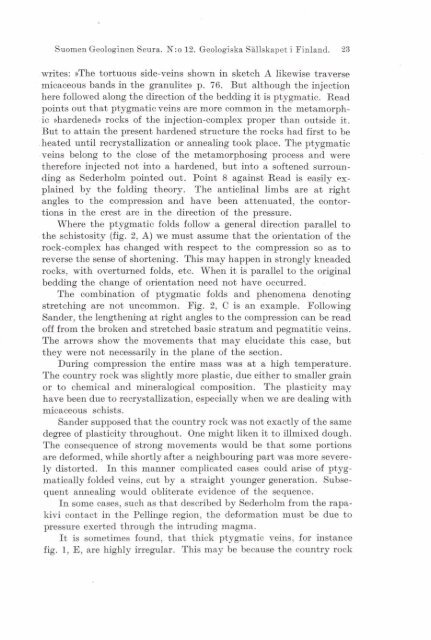GOHMISSION GEOLOGIQVE - Arkisto.gsf.fi
GOHMISSION GEOLOGIQVE - Arkisto.gsf.fi
GOHMISSION GEOLOGIQVE - Arkisto.gsf.fi
Create successful ePaper yourself
Turn your PDF publications into a flip-book with our unique Google optimized e-Paper software.
Suomen Geologinen Seura. N:o 12. Ceologiska Sallskapet i Finland. 23<br />
writes: ))The tortuous side-veins shown in sketch A likewise traverse<br />
micaceous bands in the granuliteu p. 76. But although the injection<br />
here followed along the direction of the bedding it is ptygmatic. Read<br />
points out that ptygmatic veins are more common in the metamorphic<br />
8hardenedu rocks of the injection-complex proper than outside it.<br />
But to attain the present hardened structure the rocks had <strong>fi</strong>rst to be<br />
heated until recrystallization or annealing took place. The ptygmatic<br />
veins belong to the close of the metamorphosing process and were<br />
therefore injected not into a hardened, but into a softened surrounding<br />
as Sederholm pointed out. Point 8 against Read is easily explained<br />
by the folding theory. The anticlinal limbs are at right<br />
angles to the compression and have been attenuated, the contortions<br />
in the crest are in the direction of the pressure.<br />
Where the ptygmatic folds follow a general direction parallel to<br />
the schistosity (<strong>fi</strong>g. 2, A) we must assume that the orientation of the<br />
rock-complex has changed with respect to the compression so as to<br />
reverse the sense of shortening. This may happen in strongly kneaded<br />
rocks, with overturned folds, etc. When it is parallel to the original<br />
bedding the change of orientation need not have occurred.<br />
The combination of ptygmatic folds and phenomena denoting<br />
stretching are not uncommon. Fig. 2, C is an example. Following<br />
Sander, the lengthening at right angles to the compression can be read<br />
off from the broken and stretched basic stratum and pegmatitic veins.<br />
The arrows show the movements that may elucidate this case, but<br />
they were not necessarily in the plane of the section.<br />
During compression the entire mass was at a high temperature.<br />
The country rock was slightly more plastic, due either to smaller grain<br />
or to Chemical and mineralogical composition. The plasticity may<br />
have been due to recrystallization, especially when we are dealing with<br />
micaceous schists.<br />
Sander supposed that the country rock was not exactly of the same<br />
degree of plasticity throughout. One might liken it to illmixed dough.<br />
The consequence of strong movements would be that some portions<br />
are deformed, while shortly after a neighbouring part was more severely<br />
distorted. In this manner cornplicated cases could arise of ptygmatically<br />
folded veins, cut by a straight younger generation. Subsequent<br />
annealing would obliterate evidence of the sequence.<br />
In some cases, such as that described by Sederholm from the rapakivi<br />
contact in the Pellinge region, the deformation must be due to<br />
pressure exerted thmugh the intruding magma.<br />
It is sometimes found, that thick ptygmatic veins, for instance<br />
<strong>fi</strong>g. 1, E, are highly irregular. This may be because the country rock
















